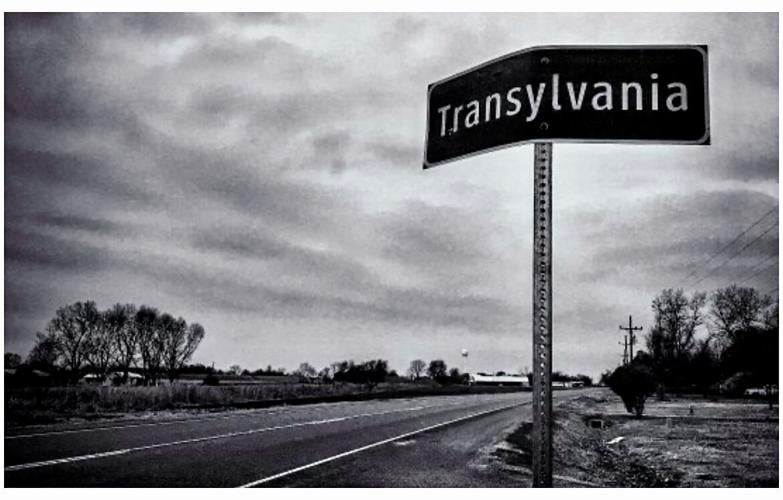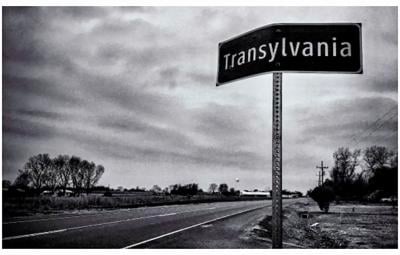I became conscious of the fact that the driver was in the act of pulling up the horses in the courtyard of a vast ruined castle, from whose tall black windows came no ray of light, and whose broken battlements showed a jagged line against the moonlit sky.
That's the scene Jonathan Harker recorded in his journal when his horse-drawn coach finally came to a stop in Transylvania in Bram Stoker's 1897 novel, "Dracula."
In all honesty, most curious travelers don't expect to see a vampire's dilapidated Gothic home when driving through northeast Louisiana's version of Transylvania. But then, there's always the thrill off a hope.

The Transylvania Post Office stands next to a sign that once advertise bat and Dracula T-shirts at the now-closed Transylvania General Store in the East Carroll Parish community of Transylvania. The post office once offered postal stamps featuring a bat.
No castles here
What they will get is lots of flat, Louisiana delta land and a smattering of structures, but there is no Dracula's castle among them.
However, that doesn't mean the Dracula spirit is absent in this unincorporated community. Travelers driving north on U.S. 65 are greeted by a bat looming at the center of its water tower some 165 feet above the highway — all of which leads to Baker Boyd's question about the origins of Transylvania's name.
The Baker resident said he's familiar with the community and was simply curious about its name, whose inspiration, he surmised, likely wasn't the Romanian home of a legendary vampire.

A bat on Transylvania's water tower welcomes travelers driving north on U.S. 65 to the community.
Turns out, Boyd is right.
A beloved university
Historical references point to the early 19th century, when a man named W.L. Richards purchased a large acreage in what is now East Carroll Parish. He named it for his beloved alma mater, Transylvania University in Lexington, Kentucky. The university also wasn't named for Romania's Transylvania, but the 1770s Transylvania Colony in western Virginia.
The colony chose the name because Transylvania's Latin translation is "across the woods."
Transylvania, Louisiana, stands 10 miles south of Lake Providence at U.S. 65's junction with La. 581 near the Mississippi River in the state's northeastern most corner. These days, selfie seekers often stop in front of the post office for a quick photo on the backdrop of the community's name.
The post office once had its own bat postmark, and the now closed Transylvania General Store sold bat T-shirts and mugs.
"We still get people who come in wanting the Transylvania postmark, but our postmark is just a regular postmark now," postal clerk Mallory Payne said. "It doesn't have a bat. It's just a quick hand stamp. It's just an itty bitty town, and there's really nothing to stop here for."

A close-up of the bat on Transylvania's water tower, which welcomes visitors to the community along U.S. 65.
Bats were once a thing
But the general store once tried to make Transylvania a tourist destination.
"The store has attracted sightseers from England, Italy, Iceland, Japan and even Romania's Transylvania — including a visitor who identified himself as a descendant of Count Dracula," writes Gay N. Martin in the travel guide, "Louisiana Off the Beaten Path: A Guide to Unique Places."
The guide was last updated in 2008, a couple of years before the general store closed and the Farmhouse at Transylvania restaurant took its place in 2011.
The restaurant closed its doors in 2018, and its name probably best coincides with the community's history of a Farm Security Administration agricultural project in the late 1930s and early 1940s. Still, stories of the general store captures the fun the community once had with its name.

Photographer Carol M. Highsmith's photo of the abandoned Transylvania Elementary School, abandoned in 2005 in the little East Carroll Parish community of Transylvania. Highsmith wrote that 'local wags describe the location today (as of 2020) as “creepy,” befitting the school and town’s name, taken from the Romanian region that was said to be home of the vampire Count Dracula in author Bram Stoker’s scary stories.'
"Besides food, dry goods and hardware, the owners sell life-size rubber bats, skull replicas and about 250 dozen T-shirts a year — with a bat logo," Martin continues in the travel guide. "Be sure to take a peek at the 'baby vampire bats' in a lighted box."
The lighted box, of course, was a gag with the "bats" being brick bats.
Bats — especially those of the vampire variety — didn't factor into the Farm Security Administration's resettlement project in 1938. It's official name was the LaDelta Project for Negro Farm Tenant Families in Louisiana and was among President Franklin D. Roosevelt's New Deal initiatives.
An agricultural project
According to the U.S. Department of Agriculture's National Agricultural Library, 12,024 acres of government-owned land in the area were allocated for use by the LaDelta Cooperative Association, assuring 147 Black tenant families social and economic security.

The co-op store for the Farm Security Administration's resettlement farm project in Transylvania in the late 1930s.
"The entire acreage, which will be leased by the cooperative for 99 years, will be subleased in units of approximately 38 acres each of cultivated land to members … Subleases also provide that crops shall be cooperatively processed and marketed," the National Agricultural Library states.
Land tracts were purchased from absentee landlords, and tenant houses were replaced by model five-room homes at a cost of $1,450 each.
However, Cleo Scott Brown, head of the History Matters Institute of Goose Creek, South Carolina, counters this historical account in her blog, , saying the land previously was owned by a company in Memphis and farmed by 250 Black families who were promised an opportunity to buy the land if it came up for sale.

A wagon travels to a farm in the Transylvania Project in Louisiana, a resettlement project in the late 1930s that was part of the U.S. Farm Security Administration. The project involved moving people to the area and helping them establish farms.
The land, instead, was sold to the Farm Security Administration.
"Under this New Deal program under President Roosevelt, this land would be resold to poor whites in 40-acre plots for farms," Brown writes. "Each farmer would also be provided a home and loan financing. None of the black farmers who already lived there would be allowed to purchase any of the land."
The NAACP and Black media outlets protested, and Black farmers eventually were given the opportunity to participate.
Ancient Indian mounds
Meanwhile, 30 farm units in this program were located by the Transylvania Mounds, a site that once was home to two plazas of ancient Indian mounds dating around 1400 A.D. It's believed that at least 12 mounds made up these plazas with the largest standing 34 feet high.

The Transylvania Mounds, a set of ancient Indian mounds dating to 1400 A.D., are commemorated by a Louisiana historical marker.
All were rectangular in shape with flat tops before being altered or leveled by the farming community. Only six of the mounds are now visible, all standing on private property and commemorated by a state historical marker at the intersection of La. 581 and Mound Road.
While an ancient civilization once thrived in Transylvania, Dracula is nowhere to be found.









